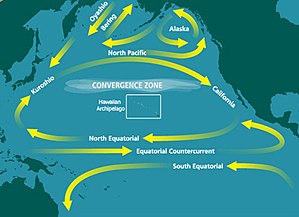
Back دوامة نفايات شمال المحيط الهادئ Arabic Вялікая ціхаакіянская смеццевая пляма Byelorussian Вялікая ціхаакіянская сьмецьцевая пляма BE-X-OLD Голямо тихоокеанско сметище Bulgarian Plastična supa BS Sopa de plàstic del Pacífic Catalan Velká tichomořská odpadková skvrna Czech Affaldsøen i det Nordlige Stillehav Danish Great Pacific Garbage Patch German Pacifika rubovortico Esperanto


The Great Pacific garbage patch (also Pacific trash vortex and North Pacific garbage patch[1]) is a garbage patch, a gyre of marine debris particles, in the central North Pacific Ocean. It is located roughly from 135°W to 155°W and 35°N to 42°N.[2] The collection of plastic and floating trash originates from the Pacific Rim, including countries in Asia, North America, and South America.[3]
Despite the common public perception of the patch existing as giant islands of floating garbage, its low density (4 particles per cubic metre (3.1/cu yd)) prevents detection by satellite imagery, or even by casual boaters or divers in the area. This is because the patch is a widely dispersed area consisting primarily of suspended "fingernail-sized or smaller"—often microscopic—particles in the upper water column known as microplastics.[4]
Researchers from The Ocean Cleanup project claimed that the patch covers 1.6 million square kilometres (620,000 square miles)[5] consisting of 45,000–129,000 metric tons (50,000–142,000 short tons) of plastic as of 2018.[6] Its goal is to remove half of the plastic pollution by 2027 using floating barriers anchored to the seabed.[7] The same 2018 study found that, while microplastics dominate the area by count, 92% of the mass of the patch consists of larger objects which have not yet fragmented into microplastics. Some of the plastic in the patch is over 50 years old, and includes items (and fragments of items) such as "plastic lighters, toothbrushes, water bottles, pens, baby bottles, cell phones, plastic bags, and nurdles".
Research indicates that the patch is rapidly accumulating.[6] The patch is believed to have increased "10-fold each decade" since 1945.[8] The gyre contains approximately six pounds of plastic for every pound of plankton.[9] A similar patch of floating plastic debris is found in the Atlantic Ocean, called the North Atlantic garbage patch.[10][11] This growing patch contributes to other environmental damage to marine ecosystems and species.
- ^ Lebreton, Laurent; Royer, Sarah-Jeanne; Peytavin, Axel; Strietman, Wouter Jan; Smeding-Zuurendonk, Ingeborg; Egger, Matthias (1 September 2022). "Industrialised fishing nations largely contribute to floating plastic pollution in the North Pacific subtropical gyre". Scientific Reports. 12 (1): 12666. Bibcode:2022NatSR..1212666L. doi:10.1038/s41598-022-16529-0. ISSN 2045-2322. PMC 9436981. PMID 36050351.
 This article incorporates text from this source, which is available under the CC BY 4.0 license.
This article incorporates text from this source, which is available under the CC BY 4.0 license.
- ^ See the relevant sections below for specific references concerning the discovery and history of the patch. A general overview is provided in Dautel, Susan L. (2007). "Transoceanic Trash: International and United States Strategies for the Great Pacific Garbage Patch". Golden Gate University Environmental Law Journal. 3 (1): 181.
- ^ "World's largest collection of ocean garbage is twice the size of Texas". USA Today. Archived from the original on 15 February 2020. Retrieved 29 April 2018.
- ^ Philp, Richard B. (2013). Ecosystems and Human Health: Toxicology and Environmental Hazards (3rd ed.). CRC Press. p. 116. ISBN 978-1466567214.
- ^ Albeck-Ripka, Livia (22 March 2018). "The 'Great Pacific Garbage Patch' Is Ballooning, 87,000,000,000 Tons of Plastic and Counting". The New York Times. ISSN 0362-4331. Archived from the original on 11 January 2020. Retrieved 26 February 2020.
- ^ a b Cite error: The named reference
Evidencewas invoked but never defined (see the help page). - ^ Evans-Pughe, Christine (February 2017). "Can we engineer our way towards cleaner oceans?". Engineering & Technology.
- ^ Maser, Chris (2014). Interactions of Land, Ocean and Humans: A Global Perspective. CRC Press. pp. 147–48. ISBN 978-1482226393.
- ^ "Great Pacific garbage patch: Plastic turning vast area of ocean into ecological nightmare". Santa Barbara News-Press. Archived from the original on 12 September 2015. Retrieved 13 October 2008.
- ^ Lovett, Richard A. (2 March 2010). "Huge Garbage Patch Found in Atlantic Too". National Geographic News. National Geographic Society. Archived from the original on 5 March 2010. Retrieved 4 March 2010.
- ^ Gill, Victoria (24 February 2010). "Plastic rubbish blights Atlantic Ocean". BBC. Archived from the original on 27 August 2017. Retrieved 16 March 2010.
© MMXXIII Rich X Search. We shall prevail. All rights reserved. Rich X Search